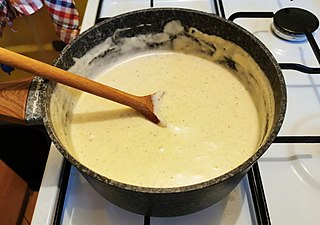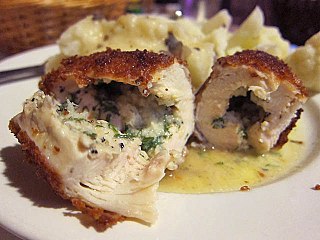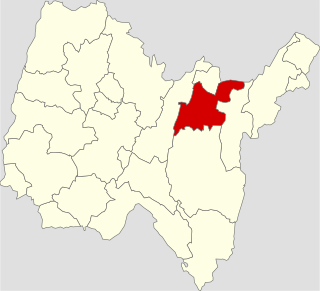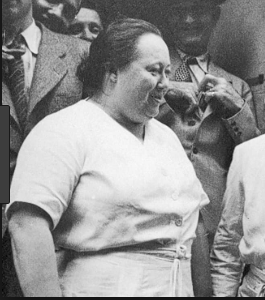
In cooking, a sauce is a liquid, cream, or semi-solid food, served on or used in preparing other foods. Most sauces are not normally consumed by themselves; they add flavor, moisture, and visual appeal to a dish. Sauce is a French word taken from the Latin salsa, meaning salted. Possibly the oldest recorded European sauce is garum, the fish sauce used by the Ancient Romans, while doubanjiang, the Chinese soy bean paste is mentioned in Rites of Zhou in the 3rd century BC.

Rhône-Alpes was an administrative region of France. Since 1 January 2016, it is part of the new region Auvergne-Rhône-Alpes. It is located on the eastern border of the country, towards the south. The region was named after the river Rhône and the Alps mountain range. Its capital, Lyon, is the second-largest metropolitan area in France after Paris. Rhône-Alpes has the sixth-largest economy of any European region.

Nantua is a commune in and subprefecture of the Ain département in the Auvergne-Rhône-Alpes region in Eastern France. The commune of Nantua comprises the glacial Lac de Nantua.

Béchamel sauce is one of the mother sauces of French cuisine.

A quenelle is a mixture of creamed fish or meat, sometimes combined with breadcrumbs, with a light egg binding, formed into an egg-like shape, and then cooked. The usual preparation is by poaching. Formerly, quenelles were often used as a garnish in haute cuisine. Today, they are more commonly served sauced as a dish in their own right. Similar items are found in many cuisines.

Chicken Kiev, also known as chicken Kyiv, is a dish made of chicken fillet pounded and rolled around cold butter, then coated with egg and bread crumbs, and either fried or baked. Since fillets are often referred to as suprêmes in professional cookery, the dish is also called "suprême de volaille à la Kiev". Stuffed chicken breast is generally known in Russian and Ukrainian cuisines as côtelette de volaille. Though it has disputed origins, the dish is particularly popular in the post-Soviet states, as well as in several other countries of the former Eastern Bloc, and in the English-speaking world.

Apremont is a commune in the department of Ain in the Auvergne-Rhône-Alpes region of eastern France.

The arrondissement of Nantua is an arrondissement of France in the Ain department in the Auvergne-Rhône-Alpes region. It has 62 communes. Its population is 93,404 (2016), and its area is 899.6 km2 (347.3 sq mi).

Fricassee or fricassée is a stew made with pieces of meat that have been browned in butter then served in a sauce flavored with the cooking stock. Fricassee is usually made with chicken, veal or rabbit, with variations limited only by what ingredients the cook has at hand.
Luxembourg's cuisine reflects the country's position between the Latin and Germanic countries, influenced by the cuisines of neighbouring France, Belgium and Germany. Recently, it has been influenced by the country's many Italian and Portuguese immigrants. As in Germany, most traditional, everyday Luxembourg dishes are of peasant origin, in contrast to the more sophisticated French fare.

The canton of Nantua is an administrative division in eastern France. At the French canton reorganisation which came into effect in March 2015, the canton was expanded from 12 to 18 communes :
A cassolette is a small porcelain, glass, or metal container used for the cooking and serving of individual dishes. The word also refers to dishes served in such a container:
Poularde Albufera, is a chicken dish attributed to French chef Adolphe Dugléré which was named in honour of the Duke of Albufera. It consists of poached chicken (poularde) with a garnish of vol-au-vents filled with quenelles, cocks' kidneys, mushrooms and truffles in Albufera sauce.
Amiral (a'l') is a particular garnish, such as poached sole, fillet of sole, stuffed turbot, or braised salmon. It contains some of the following ingredients:

Eugénie Brazier, known as "la Mère Brazier", was a French chef who, in 1933, became the first person awarded six Michelin stars, three each at two restaurants: La Mère Brazier in the rue Royale, one of the main streets of Lyon, and a second, also called La Mère Brazier, outside the city. This achievement was unmatched until Alain Ducasse was awarded six stars with the publication of the 1998 Michelin Guide.

Crayfish are eaten all over the world. Like other edible crustaceans, only a small portion of the body of a crayfish is edible. In most prepared dishes, such as soups, bisques and étouffées, only the tail portion is served. At crawfish boils or other meals where the entire body of the crayfish is presented, other portions, such as the claw meat, may be eaten.

Lyonnaise cuisine refers to cooking traditions and practices centering on the area around the French city of Lyon and historical Lyonnais culinary traditions.

The quenelle is a gesture created and popularized by French comedian Dieudonné M'bala M'bala. He first used it in 2005 in his sketch entitled "1905" about French secularism, and has used it since in a wide variety of contexts. The quenelle became popular, with many photos posted to the Internet showing individuals posing while performing quenelles at mundane places.

In French cuisine, the mother sauces, also known as grandes sauces in French, are a group of sauces upon which many other sauces – "daughter sauces" or petites sauces – are based. Different classifications of mother sauces have been proposed since at least the early 19th century.














